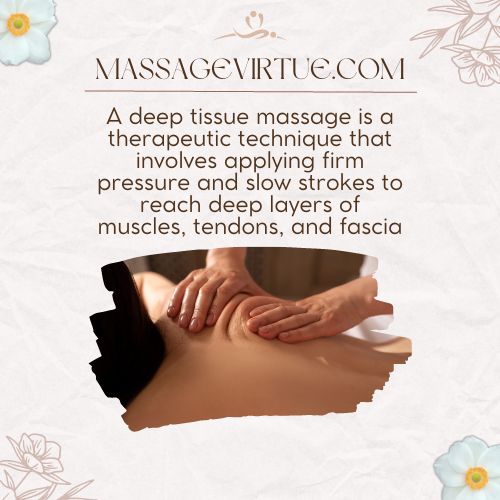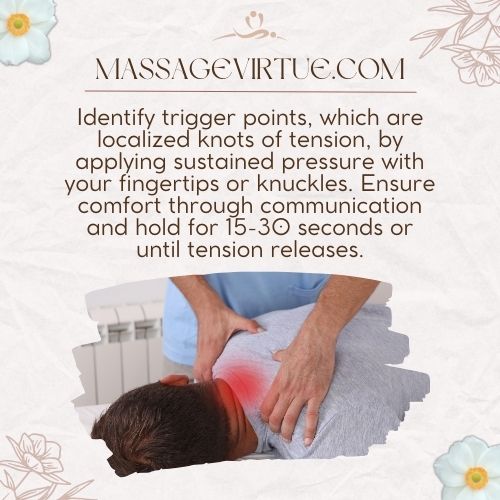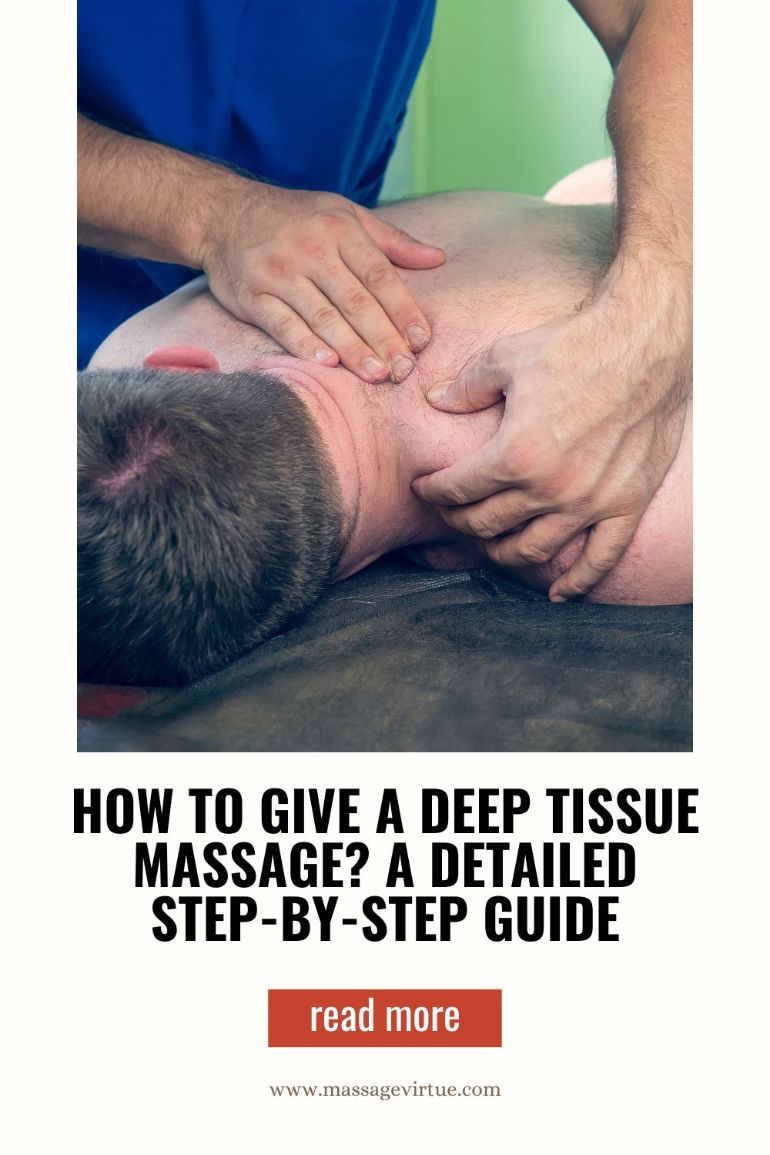If you want to learn how to give a deep tissue massage effectively, whether for personal relaxation or as a professional skill, you’ve come to the right place.
In this guide, we’ll provide you with a straightforward and informative step-by-step approach to mastering the art of deep tissue massage.
By the end of this article, you’ll be equipped with the knowledge and techniques to relieve muscle tension, address chronic pain, and target specific areas of the body using deep-tissue massage therapy.
What is a Deep Tissue Massage?
Deep tissue massage is a therapeutic technique used to address muscle tension and chronic pain.

It involves applying firm pressure to reach the deeper layers of muscles.
This massage type is beneficial for various body parts, including the back, neck, shoulders, arms, legs, and feet.
How to Give a Deep Tissue Massage? A Step-By-Step Guide
Deep tissue massage is a centuries-old therapy for targeted relief. Let’s learn it from scratch.
Step 1: Gather Your Supplies
Before you begin, gather the following supplies:
- Deep Tissue Massage Oil: Choose a high-quality oil designed for deep tissue work.
- Comfortable Massage Table or Mat: Ensure your recipient is comfortable during the massage.
- Clean Towels: Have clean towels ready for wiping excess oil.
- Relaxing Atmosphere: Create a peaceful ambiance with soft lighting and soothing music.
Step 2: Prepare Your Recipient
Ensure your recipient is comfortable and informed:
- Explain the deep tissue massage process and ask about any specific concerns or areas of discomfort.
- Have them lie face down on the massage table or mat, using towels for modesty and comfort.
- Encourage deep and steady breathing to enhance relaxation.
Step 3: Warm-Up with Effleurage
Begin with effleurage, a gentle gliding stroke, to warm up the muscles:
- Apply deep tissue massage oil to your hands and the recipient’s skin.
- Use long, sweeping strokes with your palms, gradually applying more pressure.
- Start at the back, working your way from the neck to the lower back.
Step 4: Apply Petrissage and Friction Techniques
Now, focus on deeper techniques:
- Use petrissage, and kneading motions, to target muscle knots and tension.
- Incorporate friction by applying pressure across muscle fibers.
- Pay attention to areas with chronic pain or muscle tightness.
Step 5: Address Trigger Points
Identify trigger points, which are localized knots of tension:
- Apply sustained pressure with your fingertips or knuckles on trigger points.
- Communicate with your recipient to ensure the pressure is comfortable but effective.
- Hold for 15-30 seconds or until you feel the tension release.

Step 6: Perform Muscle Compression and Stretching
To further alleviate tension and increase flexibility:
- Apply muscle compression by pressing down on tense areas with your palms.
- Incorporate stretching techniques to gently elongate muscles.
- Focus on areas such as shoulders, arms, legs, and feet.
Step 7: Seek Feedback and Adjust
Throughout the massage, encourage open communication:
- Ask your recipient for feedback on pressure and comfort.
- Adjust your techniques based on their responses.
- Ensure they feel relaxed and at ease throughout the session.
Step 8: Finish with Effleurage and Rest
Wrap up the massage with effleurage strokes:
- Use gentle, soothing strokes to calm the muscles.
- Allow your recipient to rest quietly for a few moments.
- Offer water to help flush out toxins released during the massage.
Benefits of Deep Tissue Massage
Deep tissue massage offers numerous benefits, making it a sought-after technique for relaxation and pain relief. Here are some key advantages:
- Muscle Tension Relief: Deep tissue massage can effectively release muscle tension, helping you or your client experience relaxation and improved flexibility.
- Chronic Pain Management: It’s an excellent choice for managing chronic pain conditions, such as lower back pain and fibromyalgia.
- Trigger Point Therapy: This technique identifies and works on specific trigger points, reducing pain and discomfort.
After Massage Tips
| After-Massage Tips | Description |
| Stay Hydrated | Drink plenty of water to flush out toxins. |
| Rest and Relax | Give your body time to fully benefit from the massage. |
| Avoid Heavy Meals | Wait at least an hour before eating a heavy meal. |
| Gentle Stretching | Perform gentle stretches to maintain flexibility. |
| Take It Easy | Avoid strenuous activities for the rest of the day. |
| Follow the Therapist’s Advice | If your therapist provides specific post-massage instructions, follow them. |
| Enjoy Quiet Time | Spend some quiet, relaxing time to unwind further. |
Conclusion
Now that you’ve learned how to give a deep tissue massage, you can provide relief from muscle tension and chronic pain.
Remember to practice and refine your techniques, always focusing on the recipient’s comfort and well-being.
Incorporate these deep-tissue massage techniques into your personal or professional repertoire, and you’ll be on your way to providing effective and soothing massages that benefit both body and mind.
FAQs
What Body Parts Should Not Be Massaged?
Avoid massaging areas with open wounds, bruises, rashes, or recent surgeries. Also, steer clear of sensitive areas like the eyes, genitals, and any painful or inflamed body parts.
What Not to Do Before a Deep Tissue Massage?
Before a deep tissue massage, avoid consuming heavy meals, alcohol, or caffeine.
Also, don’t engage in strenuous exercise right before the massage, and be sure to communicate any health concerns or allergies to your therapist.
Why Do They Say Not to Shower After a Massage?
Showering immediately after a massage can wash away the massage oils and reduce the benefits of the treatment. It’s better to wait a few hours to let the oils penetrate the skin.
Where Do You Start a Deep Tissue Massage?
Begin a deep tissue massage on the back, as it’s a common starting point. Gradually work your way to other areas like the neck, shoulders, arms, legs, and feet.
Do You Take Clothes Off for Deep Tissue Massage?
Most people undress to their comfort level. Typically, you undress to your underwear or fully, depending on your preference.
The therapist will ensure you are appropriately covered with a sheet or towel during the massage.


